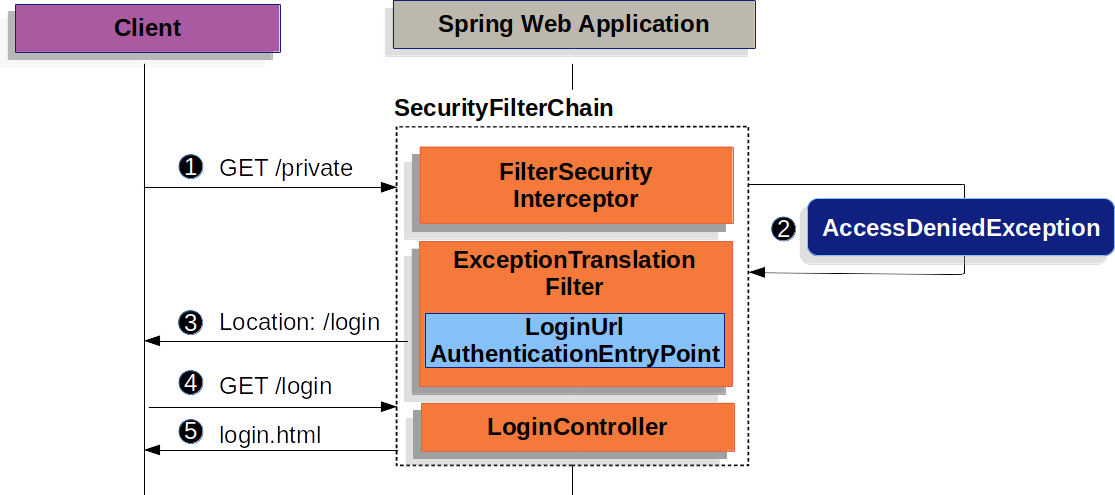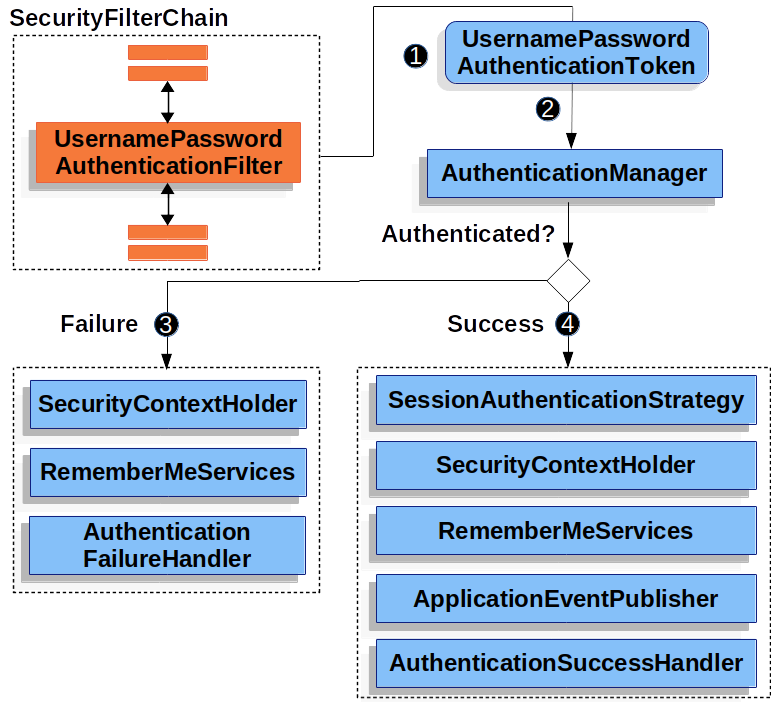|
对于最新的稳定版本,请使用 Spring Security 6.5.3! |
表单登录
Spring Security 支持通过 HTML 表单提供用户名和密码。 本节详细介绍了基于表单的身份验证在 Spring Security 中的工作原理。
本节研究基于表单的登录在 Spring Security 中的工作原理。 首先,我们看到用户是如何重定向到登录表单的:

上图基于我们的SecurityFilterChain图。
![]() 首先,用户向资源 (
首先,用户向资源 (/private)未授权。
![]() Spring Security 的
Spring Security 的FilterSecurityInterceptor表示通过抛出AccessDeniedException.
![]() 由于用户未经过身份验证,
由于用户未经过身份验证,ExceptionTranslationFilter启动启动身份验证,并发送重定向到登录页面,并配置AuthenticationEntryPoint.
在大多数情况下,AuthenticationEntryPoint是LoginUrlAuthenticationEntryPoint.
![]() 浏览器请求将其重定向到的登录页面。
浏览器请求将其重定向到的登录页面。
![]() 应用程序中的某些内容必须呈现登录页面。
应用程序中的某些内容必须呈现登录页面。
提交用户名和密码后,UsernamePasswordAuthenticationFilter验证用户名和密码。
这UsernamePasswordAuthenticationFilterextends AbstractAuthenticationProcessingFilter,因此下图应该看起来非常相似:

该图建立在我们的SecurityFilterChain图。
![]() 当用户提交用户名和密码时,
当用户提交用户名和密码时,UsernamePasswordAuthenticationFilter创建一个UsernamePasswordAuthenticationToken,这是一种Authentication,通过从HttpServletRequest实例。
![]() 接下来,
接下来,UsernamePasswordAuthenticationToken被传递到AuthenticationManager要验证的实例。
什么的细节AuthenticationManager看起来取决于用户信息的存储方式。
![]() 如果身份验证失败,则失败。
如果身份验证失败,则失败。
-
RememberMeServices.loginFail被调用。 如果记住我没有配置,这是一个无作。 请参阅RememberMeServicesJavadoc 中的接口。 -
AuthenticationFailureHandler被调用。 请参阅AuthenticationFailureHandler类
![]() 如果身份验证成功,则成功。
如果身份验证成功,则成功。
-
SessionAuthenticationStrategy会收到新登录的通知。 请参阅SessionAuthenticationStrategyJavadoc 中的接口。 -
身份验证是在 SecurityContextHolder 上设置的。 请参阅
SecurityContextPersistenceFilter类。 -
RememberMeServices.loginSuccess被调用。 如果记住我没有配置,这是一个无作。 请参阅RememberMeServicesJavadoc 中的接口。 -
ApplicationEventPublisher发布一个InteractiveAuthenticationSuccessEvent. -
这
AuthenticationSuccessHandler被调用。通常,这是一个SimpleUrlAuthenticationSuccessHandler,重定向到由ExceptionTranslationFilter当我们重定向到登录页面时。
默认情况下,启用 Spring Security 表单登录。 但是,一旦提供了任何基于 servlet 的配置,就必须显式提供基于表单的登录。 以下示例显示了最小的显式 Java 配置:
-
Java
-
XML
-
Kotlin
public SecurityFilterChain filterChain(HttpSecurity http) {
http
.formLogin(withDefaults());
// ...
}<http>
<!-- ... -->
<form-login />
</http>open fun filterChain(http: HttpSecurity): SecurityFilterChain {
http {
formLogin { }
}
// ...
}在前面的配置中,Spring Security 呈现默认登录页面。 大多数生产应用程序都需要自定义登录表单。
以下配置演示了如何提供自定义登录表单。
-
Java
-
XML
-
Kotlin
public SecurityFilterChain filterChain(HttpSecurity http) {
http
.formLogin(form -> form
.loginPage("/login")
.permitAll()
);
// ...
}<http>
<!-- ... -->
<intercept-url pattern="/login" access="permitAll" />
<form-login login-page="/login" />
</http>open fun filterChain(http: HttpSecurity): SecurityFilterChain {
http {
formLogin {
loginPage = "/login"
permitAll()
}
}
// ...
}在 Spring Security 配置中指定登录页面时,您负责渲染该页面。
以下 Thymeleaf 模板生成一个符合/login.:
<!DOCTYPE html>
<html xmlns="http://www.w3.org/1999/xhtml" xmlns:th="https://www.thymeleaf.org">
<head>
<title>Please Log In</title>
</head>
<body>
<h1>Please Log In</h1>
<div th:if="${param.error}">
Invalid username and password.</div>
<div th:if="${param.logout}">
You have been logged out.</div>
<form th:action="@{/login}" method="post">
<div>
<input type="text" name="username" placeholder="Username"/>
</div>
<div>
<input type="password" name="password" placeholder="Password"/>
</div>
<input type="submit" value="Log in" />
</form>
</body>
</html>关于默认 HTML 表单有几个关键点:
-
表单应执行
post自/login. -
该表单需要包含一个 CSRF Tokens,该Tokens由 Thymeleaf 自动包含。
-
表单应在名为
username. -
表单应在名为
password. -
如果名为
error找到,则表示用户未能提供有效的用户名或密码。 -
如果名为
logout找到,则表示用户已成功注销。
许多用户只需要自定义登录页面。 但是,如果需要,您可以使用其他配置自定义前面显示的所有内容。
如果您使用 Spring MVC,则需要一个映射GET /login到我们创建的登录模板。
以下示例显示了最小的LoginController:
-
Java
-
Kotlin
@Controller
class LoginController {
@GetMapping("/login")
String login() {
return "login";
}
}@Controller
class LoginController {
@GetMapping("/login")
fun login(): String {
return "login"
}
}